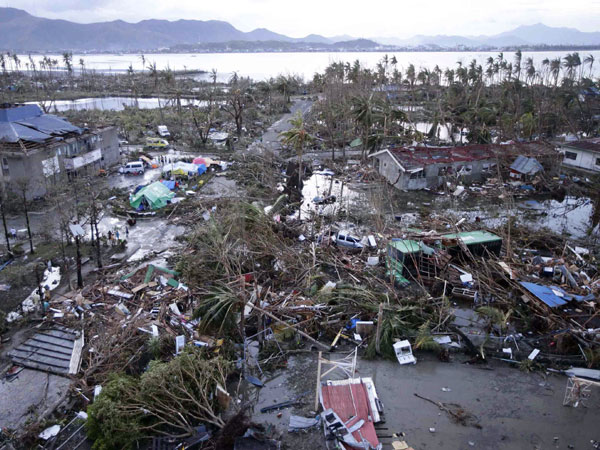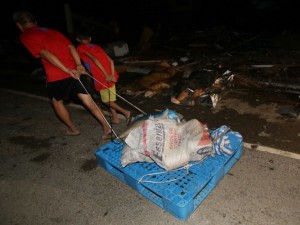More than 10,000 feared dead in typhoon-ravaged Philippines
Tacloban City is reduced to vast wasteland after the onslaught of super typhoon “Yolanda.” Video by INQUIRER.net’s Ryan Leagogo
TACLOBAN CITY, Philippines — The death toll from a supertyphoon that decimated entire towns in the Philippines could soar well over 10,000, authorities warned Sunday, making it the country’s worst recorded natural disaster.
The horrifying estimates came as rescue workers appeared overwhelmed in their efforts to help countless survivors of Super Typhoon Haiyan, which sent tsunami-like waves and merciless winds rampaging across a huge chunk of the archipelago on Friday.
Police said they had deployed special forces to contain looters in Tacloban, the devastated provincial capital of Leyte, while the United States announced it had responded to a Philippine government appeal and would send military help.
Article continues after this advertisement
Tacloban Airport is covered by debris after powerful Typhoon Haiyan hit Tacloban city, in Leyte province in central Philippines, Saturday, Nov. 9, 2013. AP
“Tacloban is totally destroyed. Some people are losing their minds from hunger or from losing their families,” high school teacher Andrew Pomeda, 36, told AFP, as he warned of the increasing desperation of survivors.
Article continues after this advertisement“People are becoming violent. They are looting business establishments, the malls, just to find food, rice and milk… I am afraid that in one week, people will be dying from hunger.”
Authorities were struggling to even understand the sheer magnitude of the disaster, let alone react to it, with the regional police chief for Leyte saying 10,000 people were believed to have died in that province alone.
“We had a meeting last night with the governor and, based on the government’s estimates, initially there are 10,000 casualties (dead),” Chief Superintendent Elmer Soria told reporters in Tacloban.
“About 70 to 80 percent of the houses and structures along the typhoon’s path were destroyed.”
On the neighboring island of Samar, a local disaster chief said 300 people were killed in the small town of Baser.
He added another 2,000 were missing there and elsewhere on Samar, which was one of the first areas to be hit when Haiyan swept in from the Pacific Ocean with maximum sustained winds of 315 kilometers an hour.
Dozens more people were confirmed killed in other flattened towns and cities across a 600-kilometer (370-mile) stretch of islands through the central Philippines.
Deadliest natural disaster
The Philippines endures a seemingly never-ending pattern of deadly typhoons, earthquakes, volcano eruptions and other natural disasters.

Residents pulling relief goods pass by dead bodies that lie on the street after powerful Typhoon Haiyan slammed into Tacloban city, Leyte province central Philippines on Saturday, Nov. 9, 2013. AP
This is because it is located along a typhoon belt and the so-called Ring of Fire, a vast Pacific Ocean region where many of Earth’s earthquakes and volcanic eruptions occur.
However, if the feared death toll of above 10,000 is correct, Haiyan would be the deadliest natural disaster ever recorded in the Philippines.
Until Haiyan, the deadliest disaster in the Philippines was in 1976, when a tsunami triggered by a magnitude 7.9 earthquake devastated the Moro Gulf on the southern Philippine island of Mindanao, killing between 5,000 and 8,000 people.
Haiyan set other apocalyptic-style records with its winds making it the strongest typhoon in the world this year, and one of the most powerful ever recorded.
Witnesses in Tacloban recalled waves up to five meters (17 feet) high surging inland, while aerial photos showed entire neighborhoods destroyed with trees and buildings flattened by storm surges that reached deep inland.
“The effects are very similar to what I have seen in a tsunami rather than a typhoon,” the Philippine country director of the World Food Program, Praveen Agrawal, who visited Tacloban, told AFP.
“All the trees are bent over, the bark has been stripped off, the houses have been damaged. In many cases they have collapsed.”
In Washington, the Pentagon announced that US Defense Secretary Chuck Hagel had responded to a request from the Philippines for military aid.
“Secretary Hagel has directed US Pacific Command to support US government humanitarian relief operations in the Philippines in the wake of Typhoon Haiyan,” it said.
“The initial focus includes surface maritime search and rescue, medium-heavy helicopter lift support, airborne maritime search and rescue, fixed wing lift support and logistics enablers.”
United Nations leader Ban Ki-moon also pledged that UN humanitarian agencies would “respond rapidly to help people in need.”
Ban is “deeply saddened by the extensive loss of life” and devastation caused by Haiyan, said UN spokesman Martin Nesirky in a statement.
Haiyan moved out of the Philippines and into the South China Sea on Saturday, from where it tracked towards Vietnam.
Although it weakened out at sea, more than 600,000 people were evacuated in Vietnam ahead of its expected landfall on Monday morning.
RELATED STORIES:
Chaos, dead bodies on typhoon-ravaged streets of Tacloban City
151 killed by ‘Yolanda’; 4.5M people affected – NDRRMC
120 policemen deployed to prevent looting in Tacloban City
Originally posted: 10:16 am | Sunday, November 10th, 2013